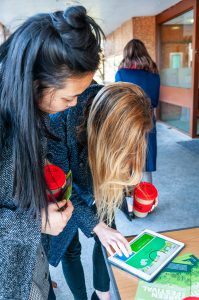 Our latest annual environmental sustainability report, covering the 2019/20 academic year, is now available here.
Our latest annual environmental sustainability report, covering the 2019/20 academic year, is now available here.
The report summarises progress against our key sustainability targets over the past 12 months, reviews wider sustainability initiatives and looks to the upcoming year. This year, we have also had to take into account the impacts of Covid-19 in our reporting; so as well as reporting our absolute impacts on the environment, where possible, we have also included progress to the end of January 2020.
Highlights
By January 2020, the University had achieved a 44% reduction in its carbon footprint compared to its 2008/9 baseline. This is 1% shy of our 45% reduction target for July 2021 and further solidifies the University as a sector leader - this is the largest percentage of CO2 reductions of any research-intensive university in the UK.
The temporary standstill of campus activity due to the Covid-19 lockdown led to the full year emissions being 57% below baseline. We can expect emissions to somewhat increase again as operational and campus activity increases over the coming year, but we remain on track to meet and most likely exceed our July 2021 reduction target.
We have also had a unique year for waste generation. Here at Reading, we have increasingly focused on the prevention of waste (as this is the priority of the waste hierarchy) and this can sometimes have subsequent knock-on effects - for example, impacting our overall recycling rate.
In terms of waste reduction, this academic year saw a total of 35.9kg of waste generated per person, compared to the 2015/16 baseline of 61.9 kg per person. This equates to a 42% reduction in waste generated per person, massively exceeding our target of 5% per person reduction of waste by 2021 against the 2015/16 baseline. However, Covid-19 had a significant impact on waste generation, with only 10.4kg generated per person from January – July 2020. If we instead assumed the total amount of waste generated in the first half of the year had been repeated in the second half, this still leads to a 17.6% reduction compared to 2015/16.
The total annual re-use of items over the 2019/20 academic period stands at 13 tonnes, exceeding our target of 8.5 tonnes of annual re-use by 2021. This was achieved via re-use of items through the online Warp-it platform and additional routes (such as donating items to local charities).
We expect it to be very challenging to meet our 60% recycling target by 2021, as our annual recycling rate currently stands at 49%. Nevertheless, recycling rates reported to HESA’s Estates Management Record (which includes construction waste) indicate that Reading has the fourth highest recycling rate of any research-intensive University.
Our water reduction target is 30% for the academic estate by July 2021 against a 2011/12 baseline. Use during 2019/20 is estimated to have been 27% lower than the baseline (and 22% lower than 2018/19). The recent reduction is the result of two main factors; the installation of water saving devices by Thames Water in summer 2019 and the Covid-19 lockdown. Nevertheless, Reading now has the third lowest water consumption per head of any research-intensive University.
Turning to sustainable travel, the overall percentage of students and staff cycling to campus has increased to 12% from 10% in 2018 and is now at its highest level since the travel surveys started in 2012. Public transport (combined train and bus) is now at 15%, which is also at its highest.
The University recently released its new 2020 – 26 Strategic Plan, which identifies sustainability (both financial and environmental) as one of the 4 key principles underpinning the Strategy. To bring this to life, six workstreams were identified to take sustainability to new levels:
- Civic and Community Engagement,
- Catering Commerce and Farms,
- Resource Use and Waste,
- Biodiversity and Green Infrastructure,
- Education for Sustainable Development
- Carbon Management Projects.
We look forward to seeing the excellent work the workstreams produce.

